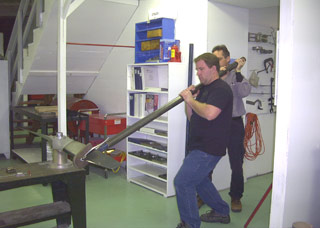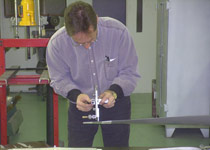 If you overhear two pilots in a conversation with the words “overhaul” or “TBO,” chances are it’s about engines. If you discover you’ve stumbled upon a discussion about constant-speed propeller overhauls, consider yourself lucky. If, upon further eavesdropping, you realize that you’ve caught two pilots talking about an overhaul of a fixed-pitch propeller, it’s time to buy a lottery ticket.
If you overhear two pilots in a conversation with the words “overhaul” or “TBO,” chances are it’s about engines. If you discover you’ve stumbled upon a discussion about constant-speed propeller overhauls, consider yourself lucky. If, upon further eavesdropping, you realize that you’ve caught two pilots talking about an overhaul of a fixed-pitch propeller, it’s time to buy a lottery ticket.
Many owners of fixed-pitch propellers are unaware that a TBO even exists for their props. But it does, and for good reason. McCauley recommends that their fixed-pitch propellers be overhauled every seven years or 2,000 hours, while Sensenich only uses 2,000 operating hours as the TBO for their propellers. These overhauls are important, both for safety and performance. Stresses build up in the outer surfaces of the blades that can be relieved by resurfacing the blade and treating for corrosion. However, another important benefit of the overhaul is the inspection and correction of blade tracking and pitch.
It’s surprising to see how many fixed-pitch propellers turn up at the overhaul with significant pitch and track issues. In the case of a friend of mine, her seemingly “good” propeller turned out to have one blade set to a pitch two inches greater than the other. She literally had a climb prop on one side and a cruise prop on the other. I can only imagine how much smoother that engine must have seemed following the prop overhaul.
Overhaul of a fixed-pitch propeller is also an excellent opportunity to make pitch changes to optimize propeller performance for your aircraft and the type of flying that you do. If you check the type certificate for your aircraft, you are likely to find a range of pitch settings that are allowed for the aircraft. They are identified in inches of theoretical forward movement during one rotation. There will usually be at least one cruise pitch setting and one climb pitch setting. As a rule of thumb, every inch of pitch change will reduce or increase the resulting engine rpm at the same power setting by 30 to 50 rpm.
That said, changing the pitch of a propeller should be carefully planned. All fixed-pitch propellers have a limit to the cumulative amount that they can be bent; commonly eight inches of pitch change. For example, if you start with a propeller pitch of 60 and increase it to 66, you can only bend the propeller pitch two more inches, in either direction, for the life of the propeller. Keep this in mind when buying a used propeller. It may be effectively run out either dimensionally or with regard to pitch changes.
If you do decide to have your fixed-pitch propeller re-pitched, you may want to see if the shop will allow you to witness the process yourself. It’s an educational experience, but it’s not for the faint of heart. Re-pitching is a remarkable ballet alternating between brute force and delicate measurement. First, the technician marks a series of points, known as stations, which are measured from the propeller hub outward on the blade face. Then, he or she uses a highly accurate protractor to measure the exact angles at every station along the propeller blades and compare them against the specs from the propeller manufacturer.
The next part can cause some heart flutter in the owner, as the technicians pull out an eight-foot steel pry bar with a fork on the end, fit it over the blade and proceed to pull, push, or hang on it in an effort to twist the blade ever so slightly. At each break in the wrestling-like action, the protractor comes back out to measure the new blade angles and determine if another round of strong-man is in order. I distinctly remember squinting in pain as I watched this process for the first time on my own propeller. That said, it clearly demonstrates the strength of propellers.
 Overhauls of constant-speed propellers are much closer in nature to engine overhauls. There are a lot of individual components that make up the hub of a constant-speed propeller and they have very close tolerances. Each must be inspected, measured, and/or replaced as necessary to meet the manufacturer’s overhaul guidelines.
Overhauls of constant-speed propellers are much closer in nature to engine overhauls. There are a lot of individual components that make up the hub of a constant-speed propeller and they have very close tolerances. Each must be inspected, measured, and/or replaced as necessary to meet the manufacturer’s overhaul guidelines.
Owners of expensive constant-speed propellers generally know the TBO of their propellers and also know that, if left unchecked, small problems can become very expensive ones. Unfortunately, they often pay attention to the hours portion of the TBO, while ignoring the age limit set by the manufacturer. This is a mistake, since corrosion is the leading cause of hub damage and corrosion is more dependent on age and environment than on operating hours. This is one reason that it is so important to get a constant-speed propeller overhauled or inspected within the recommended TBO. If you catch a problem early, the cost can be reasonable (in airplane terms). However, if the wear or corrosion damage exceeds the tolerances of the component, replacement can be a very expensive proposition.
One maintenance option that is available to owners operating under Part 91 is the “inspect and repair as necessary” or IRAN. As opposed to a complete overhaul, this procedure involves disassembly, inspection, and repair on an as-needed basis versus the overhaul requirements set by the manufacturer, which may be much more stringent on component replacement. It’s better than waiting beyond TBO, but it is also a false economy, depending on your situation. The difference in cost between an IRAN and an overhaul may be quite close, and you will still have a propeller with the same “time since overhaul” when you’re all done. Communication with the propeller shop is the key to making good decisions here. Check in with them as soon as they have completed the inspection, discuss the options, and make an informed decision.
Propellers deserve your respect and attention. Take good care of them; perform routine maintenance to prevent corrosion damage, and address minor stress points before they become major ones. Lastly, remember to give that blade a pat on the back for a job well done as you head to the baggage compartment and grab the tow bar for pulling or pushing the aircraft around the ramp; your propeller will thank you someday.



